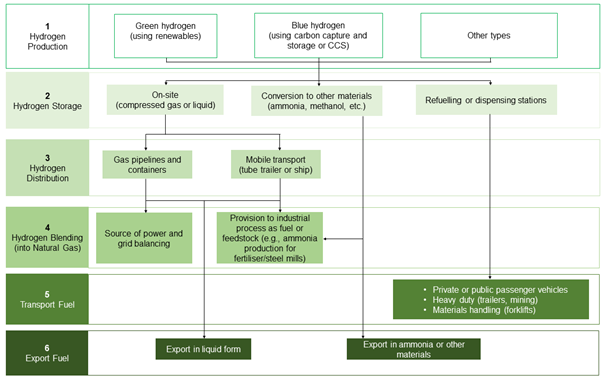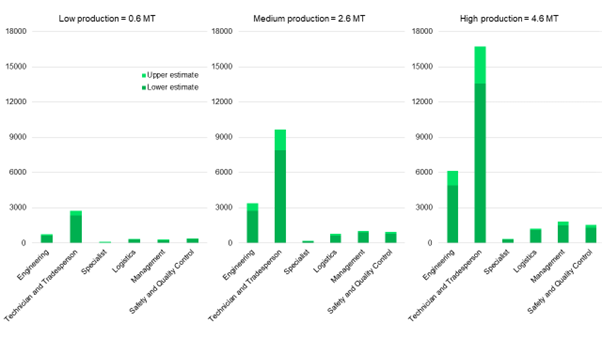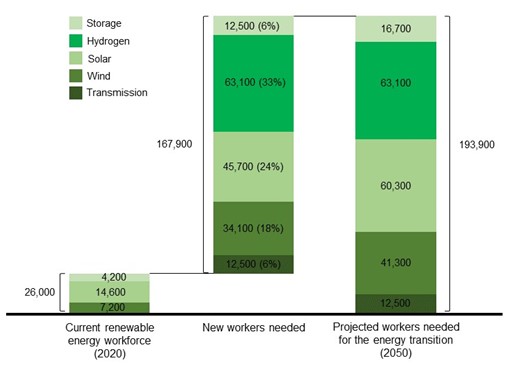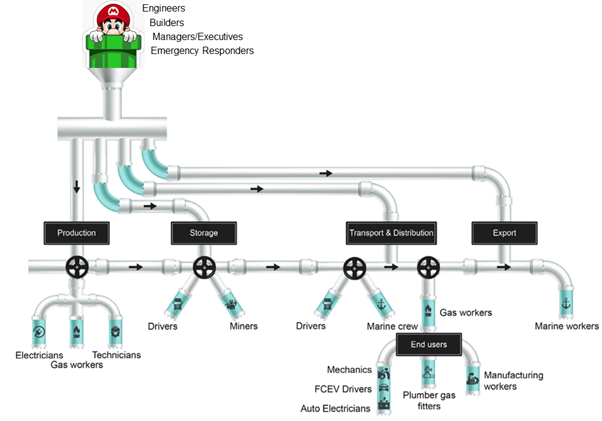Are we ready for the hydrogen workforce shift?
Are we ready for the shift to a green workforce, specifically to hydrogen advancement? When hydrogen innovations and a skilled and ready workforce are aligned, Australia will have an opportunity to become a world leader in the global hydrogen economy. But the shift to the green workforce poses two key challenges; limited workers and a skills and training gap.
The Australian Government recently announced a $95.6 million fund over nine years to support 10,000 new energy apprenticeships towards the shift to a green workforce1. This aligns with the Australian Government’s National Hydrogen Strategy2 launched in 2019, prioritising hydrogen projects in six areas. When these innovations are combined with a skilled and ready workforce, it can allow Australia to become a world leader in the global hydrogen economy.

The six hydrogen areas and supply chains3.
Several federal and state initiatives identify the workforce needed for the emerging Australian hydrogen industry4. There are two key workforce challenges that may arise:
- Limited workers to support the construction and operation of hydrogen projects, and
- Skills and training gap of the workers to perform safe and good quality jobs.
The first thing we should consider is limited workers – According to a report by Accenture we currently have around 26,000 renewable energy workers5. The transition to renewable energy to achieve Australia’s 2030 emission reduction target will require more than three times the current workers we have right now5,6. PwC3 also estimated that in 2030, the hydrogen industry alone will need about 4,000 to 28,000 skilled workers depending on the amount of hydrogen produced. This is one-fifth to more than double the renewable energy workforce we currently have .

Estimated 2030 hydrogen employment by PwC3.
In 2050, the number of workers will go up more than sevenfold to achieve Australia’s net-zero target5. Most of the needed workers (33 per cent) fall under the future hydrogen industry, which will have huge implications for a smooth energy .

Energy transition workforce projection by Accenture5*.
The second thing we should focus on is bridging the skills and training gap – The Victorian Hydrogen Hub and PwC surveyed the gas industry and identified three groups based on the gap in skills and training needed3,7.
- Green roles – Job roles that are like the current gas workers’ work. These include chemical, civil, electrical, grid connection engineers, and specialist technicians.
- Orange roles – Job roles that are like the current gas workers’ work but require bridging and contextualised training. These include general gas and electrical fitters, plumbers, electricians, electronic, mechanical, marine, and commissioning engineers, power plant and water treatment plant operators, gas inspectors, quality assurance, work health and safety officers, planners and schedulers, and managers.
- Red roles – Job roles that are not performed by gas workers right now that will require specialised training. These include welders, technicians, industrial gas fitters and industry operators, heavy-duty fitters, integration specialists, technical sales representatives, truck drivers, marine, heavy vehicle, and plant machinery operators, and stevedores.

Hydrogen jobs across supply chains7.
According to this in-depth analysis, the biggest barrier for the gas industry is the lack of hydrogen skills and training opportunities for the existing workforce7. The most impacted roles will be the more hands-on jobs including gas fitters, plumbers, drivers, and mechanics.
The reports from various studies also identified the importance of aligning the training being offered with industry standards, since many hydrogen training and education programs do not meet industry needs for the hydrogen economy3,4,7.
Luckily, the Australian Industry Standards8, educational institutions9,10, and state governments11–13 are looking at this very topic and we’re hopeful that a practical solution emerges. We can also learn from the strategies of Germany14, the Netherlands15, the UK16, and France17.
Most of the existing gas workers affected by Australia’s energy transition could transition into the green workforce with minimal . For example, general gas and electric fitters will already have pertinent skills from previous activities and education. Any upskilling or retraining will only require an understanding and hands-on experience of hydrogen’s unique property risks such as flammability and lightness. Also, the degree of upskilling and skill gap will narrow if workers from the oil and gas industry transition, as opposed for example to those from water infrastructure.
In fact, advancing hydrogen with a well-functioning labour market can offer a more “just workforce transition”. This maximises participation and is more inclusive, diverse, and equitable by matching existing gas workers with hydrogen careers.
References
(1) Australian Government. New energy apprenticeships to power Australia’s path to net zero | energy.gov.au. https://www.energy.gov.au/news-media/news/new-energy-apprenticeships-power-australias-path-net-zero (accessed 2023-02-27).
(2) COAG Energy Council. Australia’s National Hydrogen Strategy; COAG Energy Council Hydrogen Working Group: Canberra, A.C.T., 2019.
(3) PwC. National Hydrogen Skills and Training Analysis, 2022. https://www.skillsforaustralia.com/hydrogen-2/ (accessed 2023-02-22).
(4) Energy Skills Queensland. Skills Gap Analysis between the Hydrogen Sector and the Gas Industry, 2022.
(5) Accenture. Australian Industry Energy Transition Initiative, 2023. https://www.energy-transitions.org/publications/australian-industry-eti-phase-2-report/ (accessed 2023-02-22).
(6) Williamson, R. Critical hydrogen skills shortage could threaten emissions goals. RenewEconomy. https://reneweconomy.com.au/critical-hydrogen-skills-shortage-could-threaten-emissions-goals/ (accessed 2023-02-22).
(7) The Victorian Hydrogen Hub. Hydrogen Skills Roadmap; 2022. https://www.swinburne.edu.au/news/2021/09/new-report-highlights-alarming-lack-of-hydrogen-training/ (accessed 2023-02-22).
(8) Australian Industry Standards. Gas IRC Industry Outlook. Australian Industry Standards. https://www.australianindustrystandards.org.au/skills-forecast/gas-industry-industry-outlook/ (accessed 2023-02-24).
(9) Swinburne University of Technology. New report highlights alarming lack of hydrogen training. https://www.swinburne.edu.au/news/2021/09/new-report-highlights-alarming-lack-of-hydrogen-training/ (accessed 2023-02-24).
(10) North Metropolitan TAFE. Training the workforce to deliver net zero. https://www.northmetrotafe.wa.edu.au/news-and-events/training-workforce-deliver-net-zero (accessed 2023-02-24).
(11) Department of Employment, Small Business and Training. Hydrogen Industry Workforce Development Roadmap 2022-2032. https://www.publications.qld.gov.au/dataset/hydrogen-industry-workforce-development-roadmap-2022-2032 (accessed 2023-02-24).
(12) South Australian Labor. Hydrogen Jobs Plan: Powering New Jobs and Industry; Text; 2022. https://www.premier.sa.gov.au/media-releases/news-items/high-global-interest-for-south-australias-hydrogen-jobs-plan (accessed 2023-02-24).
(13) NSW Government. NSW Hydrogen Strategy worth $3 billion in incentives to drive…. Energy & Resources Knowledge Hub. https://www.energyinnovation.net.au/article/nsw-hydrogen-strategy-worth-3-billion-in-incentives-to-drive-investment-create-jobs-and-power-prosperity (accessed 2023-02-24).
(14) The German Federal Government. The National Hydrogen Strategy, 2020. https://www.bmwk.de/Redaktion/EN/Publikationen/Energie/the-national-hydrogen-strategy.pdf?__blob=publicationFile&v=6 (accessed 2023-02-24).
(15) Government of the Netherlands. Government Strategy on Hydrogen, 2020. Government Strategy on Hydrogen (accessed 2023-02-24).
(16) HM Government. UK Hydrogen Strategy; 2021. https://assets.publishing.service.gov.uk/government/uploads/system/uploads/attachment_data/file/1011283/UK-Hydrogen-Strategy_web.pdf.
(17) The French Government. Stratégie Nationale Pour Le Développement de l’hydrogène Décarboné En France, 2020. https://minefi.hosting.augure.com/Augure_Minefi/r/ContenuEnLigne/Download?id=5C30E7B2-2092-4339-8B92-FE24984E8E42&filename=DP%20-%20Strat%C3%A9gie%20nationale%20pour%20le%20d%C3%A9veloppement%20de%20l%27hydrog%C3%A8ne%20d%C3%A9carbon%C3%A9%20en%20France.pdf (accessed 2023-02-24).

